Listed here are two three few NumPy based solutions using bin based summing covering basically three scenarios.
Scenario #1 : Multiple entries per date, but no missing dates
Approach #1 :
# For now hard-coded to use Window size of 5 and stride length of 3
def vectorized_app1(df):
# Extract the index names and values
vals = df.A.values
indx = df.index.values
# Extract IDs for bin based summing
mask = np.append(False,indx[1:] > indx[:-1])
date_id = mask.cumsum()
search_id = np.hstack((0,np.arange(2,date_id[-1],3),date_id[-1]+1))
shifts = np.searchsorted(date_id,search_id)
reps = shifts[1:] - shifts[:-1]
id_arr = np.repeat(np.arange(len(reps)),reps)
# Perform bin based summing and subtract the repeated ones
IDsums = np.bincount(id_arr,vals)
allsums = IDsums[:-1] + IDsums[1:]
allsums[1:] -= np.bincount(date_id,vals)[search_id[1:-2]]
# Convert to pandas dataframe if needed
out_index = indx[np.nonzero(mask)[0][3::3]] # Use last date of group
return pd.DataFrame(allsums,index=out_index,columns=['A'])
Approach #2 :
# For now hard-coded to use Window size of 5 and stride length of 3
def vectorized_app2(df):
# Extract the index names and values
indx = df.index.values
# Extract IDs for bin based summing
mask = np.append(False,indx[1:] > indx[:-1])
date_id = mask.cumsum()
# Generate IDs at which shifts are to happen for a (2,3,5,8..) patttern
# Pad with 0 and length of array at either ends as we use diff later on
shiftIDs = (np.arange(2,date_id[-1],3)[:,None] + np.arange(2)).ravel()
search_id = np.hstack((0,shiftIDs,date_id[-1]+1))
# Find the start of those shifting indices
# Generate ID based on shifts and do bin based summing of dataframe
shifts = np.searchsorted(date_id,search_id)
reps = shifts[1:] - shifts[:-1]
id_arr = np.repeat(np.arange(len(reps)),reps)
IDsums = np.bincount(id_arr,df.A.values)
# Sum each group of 3 elems with a stride of 2, make dataframe if needed
allsums = IDsums[:-1:2] + IDsums[1::2] + IDsums[2::2]
# Convert to pandas dataframe if needed
out_index = indx[np.nonzero(mask)[0][3::3]] # Use last date of group
return pd.DataFrame(allsums,index=out_index,columns=['A'])
Approach #3 :
def vectorized_app3(df, S=3, W=5):
dt = df.index.values
shifts = np.append(False,dt[1:] > dt[:-1])
c = np.bincount(shifts.cumsum(),df.A.values)
out = np.convolve(c,np.ones(W,dtype=int),'valid')[::S]
out_index = dt[np.nonzero(shifts)[0][W-2::S]]
return pd.DataFrame(out,index=out_index,columns=['A'])
We could replace the convolution part with direct sliced summation for a modified version of it -
def vectorized_app3_v2(df, S=3, W=5):
dt = df.index.values
shifts = np.append(False,dt[1:] > dt[:-1])
c = np.bincount(shifts.cumsum(),df.A.values)
f = c.size+S-W
out = c[:f:S].copy()
for i in range(1,W):
out += c[i:f+i:S]
out_index = dt[np.nonzero(shifts)[0][W-2::S]]
return pd.DataFrame(out,index=out_index,columns=['A'])
Scenario #2 : Multiple entries per date and missing dates
Approach #4 :
def vectorized_app4(df, S=3, W=5):
dt = df.index.values
indx = np.append(0,((dt[1:] - dt[:-1])//86400000000000).astype(int)).cumsum()
WL = ((indx[-1]+1)//S)
c = np.bincount(indx,df.A.values,minlength=S*WL+(W-S))
out = np.convolve(c,np.ones(W,dtype=int),'valid')[::S]
grp0_lastdate = dt[0] + np.timedelta64(W-1,'D')
freq_str = str(S)+'D'
grp_last_dt = pd.date_range(grp0_lastdate, periods=WL, freq=freq_str).values
out_index = dt[dt.searchsorted(grp_last_dt,'right')-1]
return pd.DataFrame(out,index=out_index,columns=['A'])
Scenario #3 : Consecutive dates and exactly one entry per date
Approach #5 :
def vectorized_app5(df, S=3, W=5):
vals = df.A.values
N = (df.shape[0]-W+2*S-1)//S
n = vals.strides[0]
out = np.lib.stride_tricks.as_strided(vals,shape=(N,W),\
strides=(S*n,n)).sum(1)
index_idx = (W-1)+S*np.arange(N)
out_index = df.index[index_idx]
return pd.DataFrame(out,index=out_index,columns=['A'])
Suggestions for creating test-data
Scenario #1 :
# Setup input for multiple dates, but no missing dates
S = 4 # Stride length (Could be edited)
W = 7 # Window length (Could be edited)
datasize = 3 # Decides datasize
tidx = pd.date_range('2012-12-31', periods=datasize*S + W-S, freq='D')
start_df = pd.DataFrame(dict(A=np.arange(len(tidx))), tidx)
reps = np.random.randint(1,4,(len(start_df)))
idx0 = np.repeat(start_df.index,reps)
df_data = np.random.randint(0,9,(len(idx0)))
df = pd.DataFrame(df_data,index=idx0,columns=['A'])
Scenario #2 :
To create setup for multiple dates and with missing dates, we could just edit the df_data creation step, like so -
df_data = np.random.randint(0,9,(len(idx0)))
Scenario #3 :
# Setup input for exactly one entry per date
S = 4 # Could be edited
W = 7
datasize = 3 # Decides datasize
tidx = pd.date_range('2012-12-31', periods=datasize*S + W-S, freq='D')
df = pd.DataFrame(dict(A=np.arange(len(tidx))), tidx)

